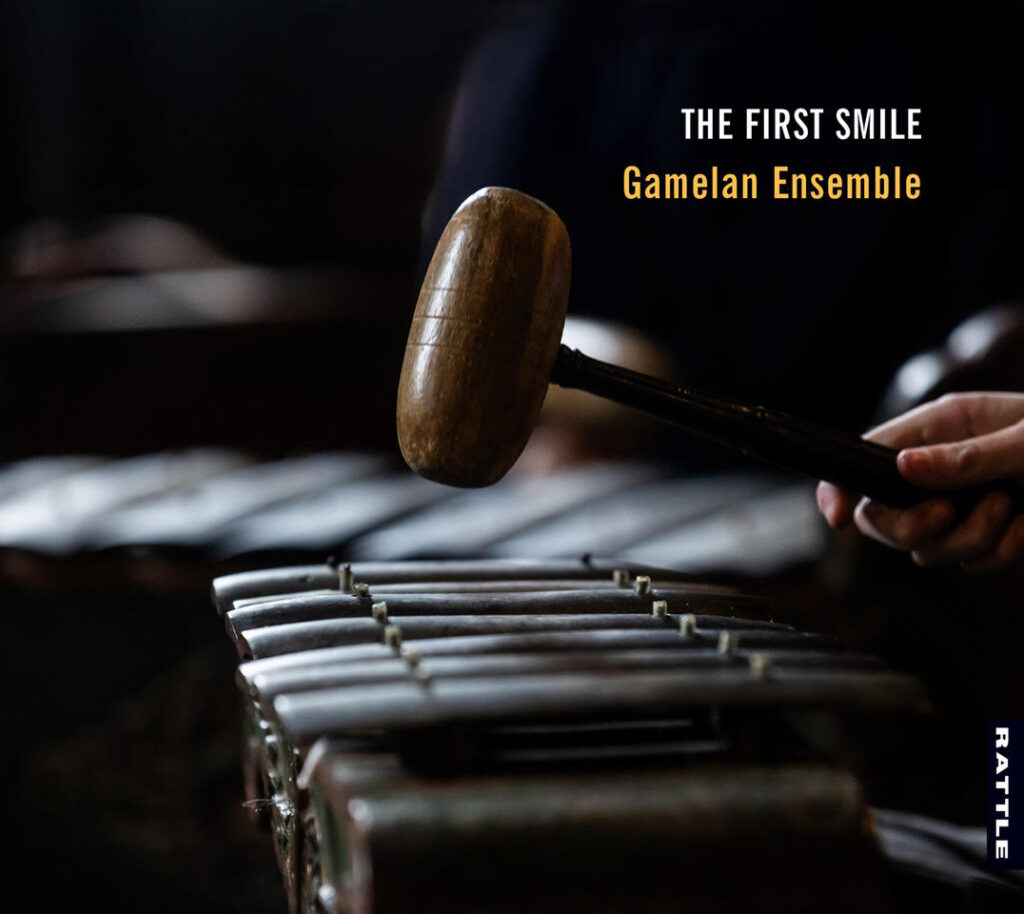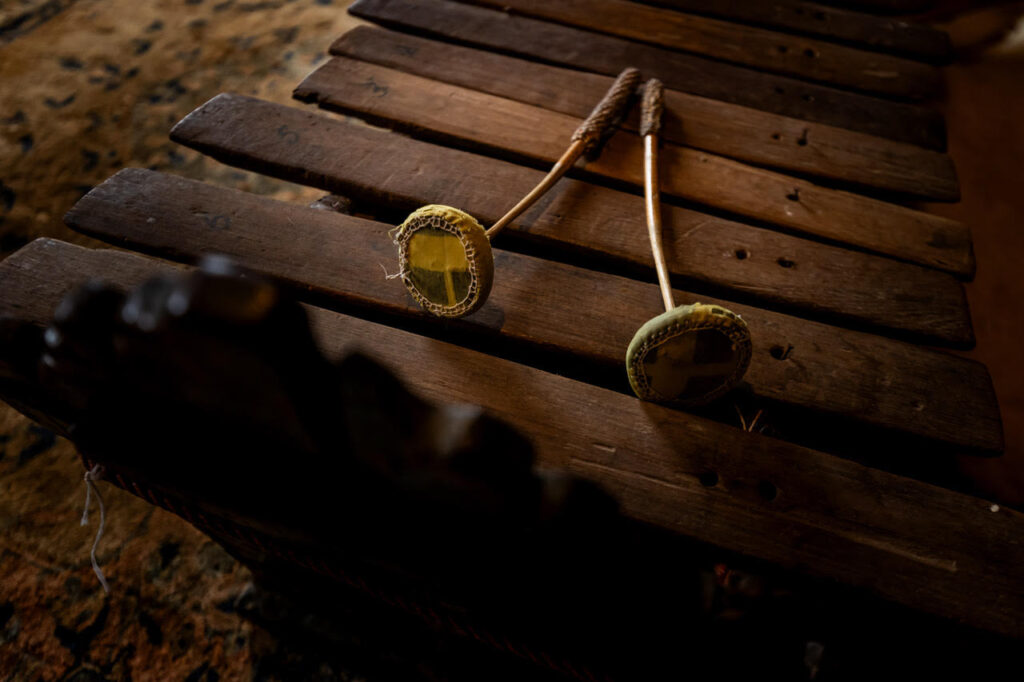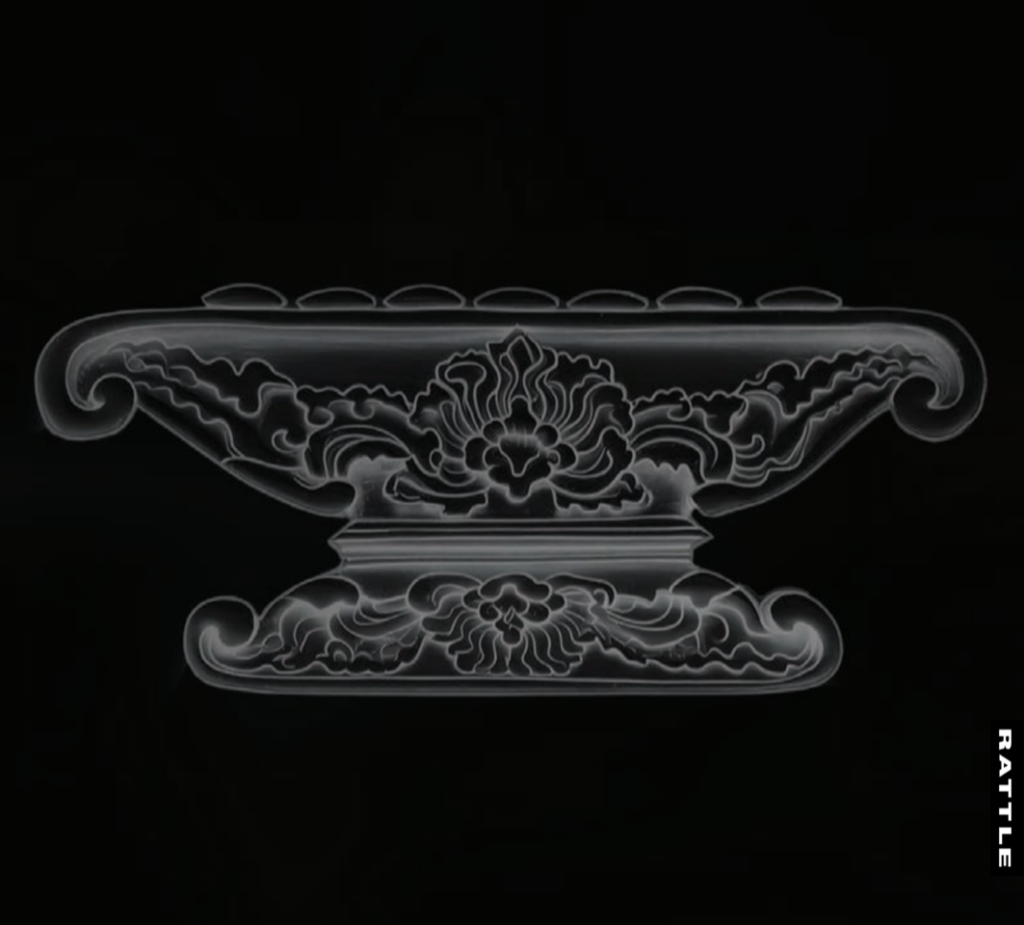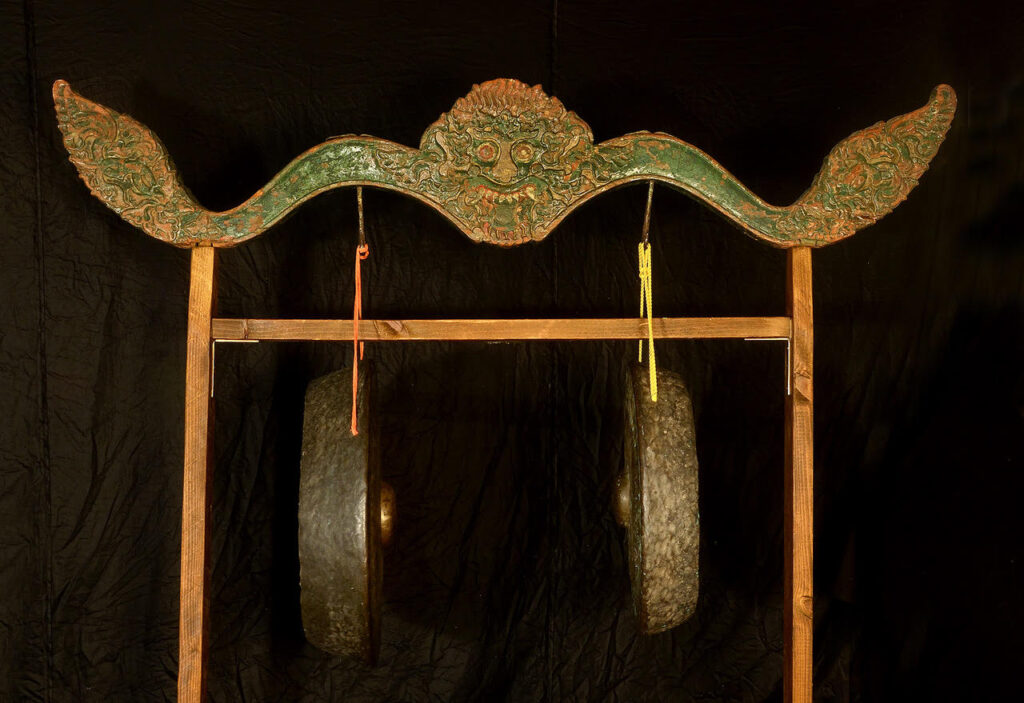 The First Smile | Gamelan Ensemble – Rattle Records (2024)
The First Smile | Gamelan Ensemble – Rattle Records (2024)
Players: Gerard Crewdson, Chris Francis, Rosalind Jiko, Helen Lowe, Hui Luo, Barbara Lyon, Keith McEwing, Jennifer Shennan
The First Smile is not really a CD, it’s a celebration!
Actually where to start with the celebrations? Nothing less than a list is in order:
*50th anniversary of the heroic role this rustic little orchestra – The First Smile – has played in New Zealand gamelan
*Feast of sensuous and intimate sounds from the rich heritage of Indonesian gamelan
*Carnival of the probing expansion of this tradition by a panoply of Kiwi composers
*Hats-off party to New Zealand’s original gamelan pioneer, patron saint of The First Smile, and all-round lovely man, Allan Thomas
*A marvelling at yet another exquisite artefact from Rattle Records, in an age where such relics have largely been devoured by the rapacious ether.
 Allan Thomas – photo by John Casey
Allan Thomas – photo by John Casey
Allan Thomas was offered this neglected little village gamelan orchestra (whose origins were at the Sultan’s Palace of Kacirebonan) in exchange for “many bags of rice”, while he was studying traditional music in Cirebon, northwest Java, in 1974. The only condition was that the gamelan would be played, not just displayed. Allan was to treat this promise as a solemn oath and over the last 50 years the ancient engineering of this Cirebon gamelan has been tested way beyond the call of duty – not bad for a taonga thought to be over 300 years old.
As The First Smile was the very first gamelan to ever arrive on these shores, 2024 was the 50th anniversary of gamelan in New Zealand. Jennifer Shennan, the well-known and loved proponent of Baroque dance and all-round powerhouse of the arts in Wellington, is now the adoring and jealous custodian of the gamelan, as Allan passed away in 2010 (Jennifer also happens to be Allan’s wife, and mother of their two daughters). Jennifer decided something special needed to be done for the gamelan’s 50th, and the result is The First Smile – the CD!
Thanks to Allan’s trailblazing, there are a dozen or so other gamelan in New Zealand these days, not the least of which is Gamelan Padhang Moncar (GPM), a grander courtly gamelan from the Central Javanese tradition, which is housed at the School of Music, Victoria University. When Allan established Ethnomusicology at Victoria, the Cirebon gamelan was the star attraction and the gateway for many students to experience a new musical universe away from the Western tradition for the first time. Later, as demand grew, the larger GPM would become the main gamelan, and when I first joined the gamelan in 1984, under Allan’s inimitably understated and just-let-it-happen guru-ship, the Cirebon gamelan was looking a little battered and not being played so much. Over the summer holidays Allan sometimes organised a leaner “commando unit” to play the Cirebon gamelan at Summer City and other events and festivals in and out of Wellington. The mysteriously smiling Jack Body was never far away either – and many other great Wellington characters. They were fun days.
Nowadays, if you snake down a little path next to Roseneath School, past “Allan’s seat”(complete with a plaque to the man himself), you’ll finally arrive at The Long Hall on a windswept promontory overlooking Wellington Harbour. In this old army barracks you will find The First Smile in pride of place. Jennifer transferred it here in 2011, and was also the mover and shaker behind the renovation of The Long Hall, which is now an active community hub. Events such as Helene Pohl and Rolf Gjelsten’s ongoing concert series now take place there, and Helene and Rolf are so delighted with The First Smile that they have programmed in a live performance of Ostinato and Cantor’s Infinity from the CD, as curtain raiser for one of the upcoming concerts (see Helene Pohl and Rolf Gjelsten ‘s “The Long Hall” Concert Series – https://middle-c.org/?s=The+Long+Hall)
 Gambang ( xylophone-type instrument, struck with soft beaters, and with wooden keys unlike other bronze-keyed instruments of The First Smile gamelan )
Gambang ( xylophone-type instrument, struck with soft beaters, and with wooden keys unlike other bronze-keyed instruments of The First Smile gamelan )
Based in this little (and long) fortress, The First Smile has had a true renaissance, and the little group practises and performs here dedicatedly. It is not easy to take the old and precious instruments out, but a generous exception was made in October 2024 for Jack!@80, a celebration of the late Jack Body’s 80th birthday at St Andrew’s-on-The-Terrace, Wellington. Featured as entrance music were Lagu Allan by Jennifer and Lagu Jack by Gerard Crewdson, especially written for the occasion (see Jack!@80 at https://middle-c.org/?s=Jack+Body).
But enough history! To the CD:
What an artefact! My CDs are now all sadly stored away due to the encroachment of newer, horribly efficient media, but this one has been placed glamorously on my bookshelf, for anything else would be a waste. Such a beautiful thing to hold: The evocative photos by John Casey and contributing artwork from Barbara Lyon…the moving stories about Allan, the composers and others…the ravishing production and design permeated with Indonesian ethos. It’s best described as a mini-coffee table book with a CD – the sort of thing we have come to expect from Steve Garden and Rattle Records, those dauntless promoters of NZ music. And credit must once again go to that most benevolent paternal spirit, The Lilburn Trust, for its grant towards the recording.
 Saron — bronze keyed instrument struck with wooden beater ( drawing by Barbara Lyon, photo John Casey )
Saron — bronze keyed instrument struck with wooden beater ( drawing by Barbara Lyon, photo John Casey )
To play the exacting CD critic for a moment: the one worry is if you open the CD with gusto (probably the case), you are more than likely to witness a UFO as the disc itself catapults across the room. But what a gorgeous orange batik UFO! – so perhaps this was the desired effect from Rattle.
The recording by Warwick Donald is miraculous. The First Smile was transported into my living room, so intimate and whispering are the sounds. Everything speaks as it should, from the piquant and limpid ringing of the bonang and saron to the soul-penetrating gorgeousness of the gong. The sound of the gong obtained here is particularly poignant for, as Allan taught me all those years ago, the large gong is usually only played occasionally at the end of cycles, but contrary to a typical Western hierarchy, it is viewed as the most important instrument, and should only be played by those with the appropriate mana.
The traditional music is the backbone of any gamelan, and for me, this is also the case with this CD. There are only two classical Cirebon pieces on this CD, due to the wealth of NZ composers that had to be packed in, but I was definitely left wanting more.
Dr. Joko Susilo, patron of The First Smile, is a gamelan leader and wayang kulit dhalang (shadow puppet master) and renowned authority on the musics of Indonesia. Joko now lives in Dunedin but is often commissioned to give workshops and performances internationally. On a recent residency at La Musée de la Musique in Paris, working with musicians of the Paris Philharmonic, Joko discovered that the ensemble they play is also from Cirebon, gifted by the Dutch to the French to mark the 100th anniversary of the French Revolution, no less. The implication of this is that the gamelan Debussy, Ravel and Satie famously first heard at the 1899 Paris Exhibition was a Cirebon gamelan. They were all utterly enchanted, and the exotic sounds and ethos were to seep subtly into their own music.
“Javanese music obeys laws of counterpoint that make Palestrina seem like child’s play,” Debussy wrote. “One will find a percussive charm that forces one to admit that our own music is not much more than a barbarous kind of noise more fit for a travelling circus.”
A simpler counterpoint than Palestrina’s is felt in the CD’s first traditional piece Sinjang Kirut (‘crumpled sarong’), but its gentle tintinnabulation, so typical of gamelan, beguiles nonetheless. Also typical is the subtle pulsing accelerando (surely the racing heart of the Cirebonese lady as she discovers her prized sarong has been crumpled?), followed by the homecoming ritardando (the lady realising her sarong is salvageable, and forgiving the delinquent boys responsible?).
Kasturun, the disc’s other traditional number, is usually used as accompaniment for female court dancers and evokes an image of angels descending from heaven. The introduction is more upbeat as it reaches into a sky full of angels, and then drops back to the earth of the balungan (backbone melody). Hypnotic and catchy, the balungan is funkily punctuated by the ketuk, with the accelerando/ritardando patterns coming in waves. In the end things are settled by the traditional final gong stroke, which in this piece comes right on top of the second to last note of the balungan –sounding a little premature and eccentric to my ears. Although, as I was informed, this is actually the accurate way to close this piece, I can see Allan giving us one of his little smiles – and certainly not “the first smile” he gave as a gamelan leader. As he always emphasised, gamelan is community music and is famously flexible with such things.
 Gong (l) Kempul (r) : ( photo John Casey)
Gong (l) Kempul (r) : ( photo John Casey)
The CD begins with the solemnly spacious and courtly Lagu Senyum Pertama (“Inner melody of The First Smile”) by Anton Killin, one of the NZ composers on the disc. Anton studied ethnomusicology with Allan at Victoria and has been prolifically involved with gamelan. Composed in 2017 for The First Smile, this lagu is based on codes using letters from each of its members. I admire the restraint of this piece, which doesn’t try to be anything other than what it is.
The world-famed US composer and gamelan expert, Lou Harrison (who in later years was also a park ranger in California) worked with Allan and Jack Body in 1983 when he came to NZ as a senior Fulbright Fellow. On the disc are two of the pieces he wrote for this very Cirebon gamelan, obviously from the hands of a master gamelan composer. Lou dedicated the pieces to Allan and Jennifer.
Lagu Lagu Thomasan sports a poised strolling balungan of decidedly strong backbone, with softly ironic and offbeat punctuation from the ketuk and kenong. A nice representation of Allan Thomas’ spirit, I’d say.
Lagu Victoria, with its understated funky riff on ketuk, and an utterly catchy balungan, takes the prize for sheer cuteness.
“The Prof”, as we used to secretly call the rather distant David Farquhar when he taught us composition (extremely dryly!) as professor of music at Victoria University, was not exactly known for the seductive charm of his music, even if he did compose Ring Round The Moon, one of the few “classical” pop hits ever to come out of New Zealand. But with Ostinato, The Prof has produced a gorgeous charmer! It’s definitely one of my favourites on the CD, and shows what an adaptive master craftsman David was. The Prof was an early adopter of Cirebon gamelan, and encouraged his students to play and compose for it soon after Allan first brought it to Victoria. David thought, to be fair, he should have a go himself, and Ostinato is the result. There’s a Spaghetti Western music feel to it – although I’m not sure the movie has been made yet…
Nhemamusasa means “building a temporary shelter from musasa branches for hunters” and Chris Francis has adapted it from mbira (“thumb piano”) music of the Shona people of Zimbabwe. Chris, an old colleague from my GPM gamelan days, has truly had a vision in bringing the people of Cirebon and Zimbabwe together through gamelan. The music works so well, it’s as if the Cirebon gamelan did indeed emerge from the savanna of southern Africa, and the somnolent fade-out at the end seems to evoke the hunters dropping off to sleep, dreaming of friendly cheetahs…
Wetonan Cycle was written in 2017 by Alison Isadora, when she was back in NZ as the Lilburn composer-in-residence after decades of living in Holland. The piece involves a story from the childhood of Joko Susilo (see above). Joko’s father was a dhalang (puppet master) in Solo, and through a timetabling mix-up caused by confusion over the Javanese 5-day week and the 7-day Gregorian calendar, Joko’s father got double-booked. As it was considered bad luck to cancel a booking, the 7-year-old Joko was brought in to replace his father for an all-night show. His celebrated success launched Joko on his dhalang and gamelan career. The 35-day cycle of the two combined calendars is called Wetonan, and Alison has created an intricate tapestry of 5- and 7-note motifs. There are also dancers and the choreography of the players as they come and go to their instruments – surely a feast to behold. The piece is composed by someone who really understands gamelan, but one senses it would be a fuller experience if in the presence of the visuals.
This richest of CDs is given the perfect ending by a real gem: Cantor’s Infinity by Gerard Crewdson. Gerard is a long-time player with The First Smile and here he uses Georg Cantor’s Theorem of Infinity to generate a series of rhythmic cycles potentially expanding into infinity. God (or Cantor) knows how Gerard does this, but magic happens here. The cycles finally morph into an ominous tolling, and Gerard himself on a trumpet wails above, thin and sepulchral, as if the Ghost of Miles Davis has been summoned to accompany The First Smile.
The First Smile and Jennifer, we need more!
How about a follow-up Rattle CD of all-Cirebon traditional music?
Or the definitive performance of Lagu Allan and Lagu Jack coupled with music by Jack Body?
Whatever happens in the recording department, Jennifer and The First Smile are busy sowing fecund gamelan seeds among the young with The Young Smile gamelan, made up of Roseneath School pupils, and The Little Smile, featuring preschool gamelaners – including several of Allan and Jennifer’s grandchildren.
Here are just two reviews of The Young Smile by its primary school members:
I feel so privileged to be able to have such an opportunity and when I found out that I was going to be able to play Gamelan I was so happy. I had just seen it and thought it was amazing but playing it is a whole other story. I also love learning about the history and origins of it and I am just so happy that I was able to do it. I also really hope when all of you reach Year Seven and Eight you get to try this magical experience. (Evie)
My favourite thing about gamelan is that every second of it is something really special. Almost no kids my age get to play gamelan not to mention with an amazing teacher. Also another really cool thing that happens is the geckos that live in the rafters, sometimes we find their shredded skins on the floor, the patterns are amazing and we’re going to make them into puppets for our gamelan story. The instruments make up a beautiful array of sound but also you can actually feel the music. (Sebi)
The future of New Zealand gamelan appears to be in good hands.